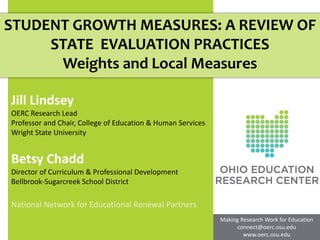
Student Growth Measures: A Review of State Evaluation Practices
- 1. STUDENT GROWTH MEASURES: A REVIEW OF STATE EVALUATION PRACTICES Weights and Local Measures Jill Lindsey OERC Research Lead Professor and Chair, College of Education & Human Services Wright State University Betsy Chadd Director of Curriculum & Professional Development Bellbrook-Sugarcreek School District National Network for Educational Renewal Partners Making Research Work for Education connect@oerc.osu.edu www.oerc.osu.edu
- 2. Changes in Teacher Evaluation Policies since 2009 36 states + DC changed teacher evaluation policies 43 states require annual evaluation of teachers 26 incorporated differentiated levels of teacher performance 32 states incorporated Student Achievement Measures (SGM) 26 states use Student Growth Percentiles (SGP) to measure & communicate SGM 39 included classroom observations 22 included multiple observations each year SGM @ Connecting the Dots Conference 3/22/2013 2
- 3. Research by Jerald and Hook 2011 graph by Hull, Center for Public Education 2011 SGM @ Connecting the Dots Conference 3/22/2013 3
- 4. States with 50%-50% Ohio Colorado Pennsylvania Florida South Dakota Idaho SGM @ Connecting the Dots Conference 3/22/2013 4
- 5. New Jersey 2013-14 Tested Grades and Subjects (20% of teachers) 50 - 50 including 35 percent student growth and 15 percent LEA measure In future years, 5 percent school-wide and cohort comparison measures in LEA measures Non-Tested Grades and Subjects (80% of teachers) 85 percent teacher practice and 15 percent student achievement In future years, 50-50 with 5 percent school-wide and cohort comparison measures and 45 percent "student growth objectives” SGM @ Connecting the Dots Conference 3/22/2013 5
- 6. Connecticut Minimum of 40% for announced and unannounced observation (a least 3 observations) 45% student growth using multiple indicators including goals/objectives with indicators and evidence and at least 22.5% based on state tests 5% student feedback 10% parent or peer feedback/survey SGM @ Connecting the Dots Conference 3/22/2013 6
- 7. Indiana 20-50% SLOs + teacher performance including observations SGM @ Connecting the Dots Conference 3/22/2013 7
- 8. Arkansas Multiple measure Including observations Including student academic growth and achievement SGM @ Connecting the Dots Conference 3/22/2013 8
- 9. New York 60% observations and performance with majority based on observations by administrator and the rest on independent trained evaluators, peer classroom observations, student and parent feedback from evaluators, and evidence of performance through student portfolios + 40% SGM with 20% based on state tests and 20% on other vendor or locally developed tests SGM @ Connecting the Dots Conference 3/22/2013 9
- 10. Tennessee 50% Observation + 35% student growth + 15% state-approved student achievement Teachers with <3yrs experience are observed 6 times a year. Experienced teachers are observed 4 times a year SGM @ Connecting the Dots Conference 3/22/2013 10
- 11. Delaware & Rhode Island No designated weights Delaware has 5 components and requires one must be student improvement/growth weighted as high as the highest other component Rhode Island requires annual student growth and achievement be included but classroom observations are optional SGM @ Connecting the Dots Conference 3/22/2013 11
- 12. 9 of the 14 States Use Danielson’s Reviewed Today Framework for Teaching as the evaluation model SGM @ Connecting the Dots Conference 3/22/2013 12
- 13. Four Levels of Performance Ratings OHIO INDIANA Accomplished Highly effective Proficient Effective Developing Improvement necessary Ineffective Ineffective CONNECTICUT SOUTH DAKOTA Exemplary Distinguished Proficient Proficient Developing Basic Below standard Unsatisfactory SGM @ Connecting the Dots Conference 3/22/2013 13
- 14. More Levels of Performance Ratings WASHINGTON & IDAHO NEW YORK Distinguished Highly Effective Proficient Effective Basic Developing Unsatisfactory Ineffective ILLINOIS ARKANSAS Excellent Feedback No Ratings Proficient Needs improvement Unsatisfactory SGM @ Connecting the Dots Conference 3/22/2013 14
- 15. District Decisions About SGM Weights, SLOs and Shared Attribution SGM @ Connecting the Dots Conference 3/22/2013 15
- 16. Partnership SGM @ Connecting the Dots Conference 3/22/2013 16
- 17. BASELINE DATA SGM @ Connecting the Dots Conference 3/22/2013 17
- 18. PROFESSIONAL DEVELOPMENT SGM @ Connecting the Dots Conference 3/22/2013 18
- 19. COLLABORATION SGM @ Connecting the Dots Conference 3/22/2013 19
- 20. SETTING GROWTH TARGETS SGM @ Connecting the Dots Conference 3/22/2013 20
- 21. SLO DEVELOPMENT Grade Level Teacher Level Building Level SGM @ Connecting the Dots Conference 3/22/2013 21
- 22. MID-YEAR REFLECTION “We do not learn from experience…. We learn from reflecting on experience.” -John Dewey SGM @ Connecting the Dots Conference 3/22/2013 22
- 23. LESSONS LEARNED Staff Development Impact on Culture Growth Target Rigor SGM @ Connecting the Dots Conference 3/22/2013 23
- 24. QUESTIONS? Making Research Work for Education connect@oerc.osu.edu www.oerc.osu.edu
